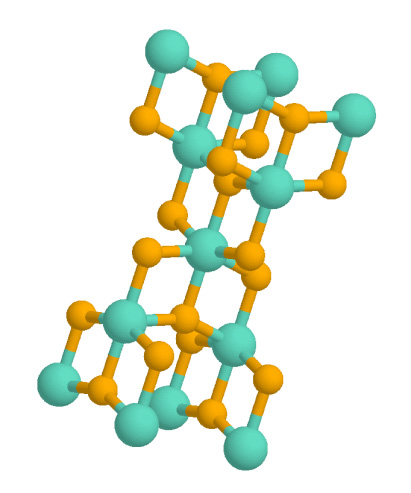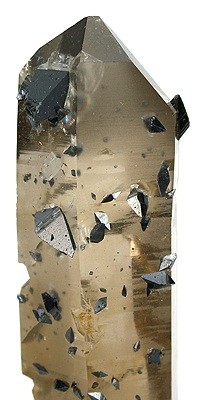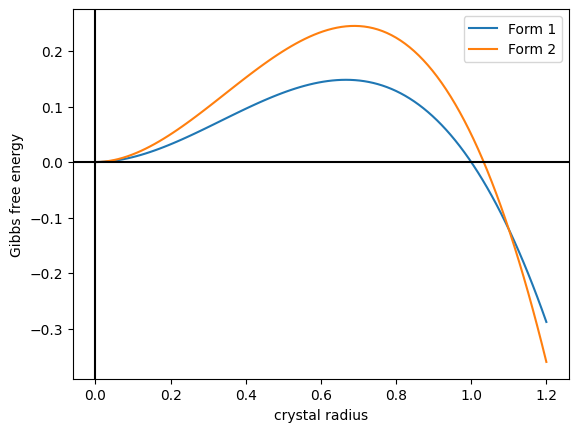|
Brookite
Brookite is the Orthorhombic crystal system, orthorhombic variant of titanium dioxide (TiO2), which occurs in four known natural Polymorphism (materials science), polymorphic forms (minerals with the same composition but different structure). The other three of these forms are akaogiite (Monoclinic crystal system, monoclinic), anatase (Tetragonal crystal system, tetragonal) and rutile (Tetragonal crystal system, tetragonal). Brookite is rare compared to anatase and rutile and, like these forms, it exhibits Photocatalysis, photocatalytic activity. Brookite also has a larger Crystal structure, cell volume than either anatase or rutile, with 8 TiO2 groups per unit cell, compared with 4 for anatase and 2 for rutile.Anatase and Brookite . Wikis.lib.ncsu.edu (2007-05-08). Retrieved on 2011-10-14. Iron (Fe), tantalum (Ta) and ... [...More Info...] [...Related Items...] OR: [Wikipedia] [Google] [Baidu] |
Titanium Dioxide
Titanium dioxide, also known as titanium(IV) oxide or titania , is the inorganic compound derived from titanium with the chemical formula . When used as a pigment, it is called titanium white, Pigment White 6 (PW6), or Colour Index International, CI 77891. It is a white solid that is insoluble in water, although mineral forms can appear black. As a pigment, it has a wide range of applications, including paint, sunscreen, and food coloring. When used as a food coloring, it has E number E171. World production in 2014 exceeded 9 million tonnes. It has been estimated that titanium dioxide is used in two-thirds of all pigments, and pigments based on the oxide have been valued at a price of $13.2 billion. Structure In all three of its main dioxides, titanium exhibits Octahedral molecular geometry, octahedral geometry, being bonded to six oxide anions. The oxides in turn are bonded to three Ti centers. The overall crystal structures of rutile and anatase are tetragonal in symmetry ... [...More Info...] [...Related Items...] OR: [Wikipedia] [Google] [Baidu] |
Armand Lévy (mineralogist)
Serve-Dieu Abailard "Armand" Lévy (14 November 1795 – 29 July 1841) was a French mathematician and mineralogist. He is remembered in the Haüy-Lévy notation for describing mineral crystal structures. Life Lévy was born in Paris where his Jewish businessman father had married Céline Mailfert, a Catholic. Although his birth and death records list his names as Serve-Dieu Abailard, he registered with the Geological Society of London under the name Armand. Armand Lévy studied mathematics and passed his agrégation in 1816 from the École Normale Supérieure. Due to his Jewish origin, he faced difficulties obtaining jobs in France and accepted a position at the Collège Royal on Reunion Island. However, while sailing to the Indian Ocean, his ship was wrecked off Plymouth. Subsequently, he settled in London, where he made a living by giving mathematics lessons. In 1820, he met mineral dealer Henry Heuland, who asked him to categorise his collection for sale to Charles Hampden T ... [...More Info...] [...Related Items...] OR: [Wikipedia] [Google] [Baidu] |
Oxide Minerals
The oxide mineral class includes those minerals in which the oxide anion (O2−) is bonded to one or more metal alloys. The hydroxide-bearing minerals are typically included in the oxide class. Minerals with complex anion groups such as the Silicate mineral, silicates, Sulfate mineral, sulfates, carbonate mineral, carbonates and Phosphate mineral, phosphates are classed separately. Simple oxides *XO form **Periclase group ***Periclase ***Manganosite **Zincite group ***Zincite ***Bromellite ***Tenorite ***Litharge * form **Cuprite **Ice * form **Hematite group ***Corundum ***Hematite ***Ilmenite * form **Rutile group ***Rutile ***Pyrolusite ***Cassiterite **Baddeleyite **Uraninite **Thorianite * form **Spinel group ***Spinel ***Gahnite ***Magnetite ***Franklinite ***Chromite **Chrysoberyl **Columbite *Hydroxide subgroup: **Brucite **Manganite **Romanèchite **Goethite group: ***Diaspore ***Goethite Nickel–Strunz class 4: oxides Internationa ... [...More Info...] [...Related Items...] OR: [Wikipedia] [Google] [Baidu] |
Murun Massif
Murun () is a mountain in the Olyokma-Chara Plateau, at the border of Irkutsk Oblast and Yakutia, Russian Federation. Geography A high summit is the highest point of the Murun Massif in the Olyokma-Chara Plateau, part of the South Siberian mountain system. The massif is about across and rises in the central/southern part of the plateau, above the right bank of the Chara, west of the valley of the Tokko, at the southwestern end of the Sakha Republic, bordering with Irkutsk Oblast, near the tripoint with Zabaykalsky Krai. The mountain is near Torgo, an abandoned settlement in Olyokminsky District.Google Earth The Murun peak is marked as a summit in the O-50 sheet of the Soviet Topographic Map. This same mountain, however, is a peak in the D-7 sheet of the Defense Mapping Agency Navigation charts. The Irkutsk Oblast-Yakutia border runs across the middle of the Murun Massif and the peak rises on the western, or Irkutsk Oblast side. Geology The massif is part of the Aldan ... [...More Info...] [...Related Items...] OR: [Wikipedia] [Google] [Baidu] |
Henry James Brooke
Henry James Brooke (1771–1857) was an English crystallographer. Life Brooke was the son of a broadcloth manufacturer, born in Exeter on 25 May 1771. He studied for the bar, but went into business in the Spanish wool trade, South American mining companies, and the London Life Assurance Association successively. Brooke's hobbies were mineralogy, geology, and botany. His large collections of shells and of minerals were presented to the University of Cambridge, while a portion of his collection of engravings was given by him to the British Museum. He was elected a Fellow of the Geological Society in 1815, Fellow of the Linnean Society in 1818, Fellow of the Royal Society in 1819, and a Foreign Honorary Member of the American Academy of Arts and Sciences in 1825. . He discovered thirteen new mineral species. Brooke died at Clapham Rise on 26 June 1857 and was buried at West Norwood Cemetery. The surgeon Charles Brooke was his son. Works Brooke published a ''Familiar Introductio ... [...More Info...] [...Related Items...] OR: [Wikipedia] [Google] [Baidu] |
Anatase
Anatase is a metastable mineral form of titanium dioxide (TiO2) with a Tetragonal crystal system, tetragonal crystal structure. Although colorless or white when pure, anatase in nature is usually a black solid due to impurities. Three other Polymorphism (materials science), polymorphs (or mineral forms) of titanium dioxide are known to occur naturally: brookite, akaogiite, and rutile, with rutile being the most common and most Chemical stability, stable of the bunch. Anatase is formed at relatively low temperatures and found in minor concentrations in Igneous rock, igneous and Metamorphic rock, metamorphic rocks. Glass coated with a thin film of TiO2 shows Anti-fog, antifogging and Self-cleaning surfaces, self-cleaning properties under ultraviolet radiation. Anatase is always found as small, isolated, and sharply developed crystals, and like rutile, it crystallizes in a Tetragonal crystal system, tetragonal system. Anatase is metastable at all temperatures and pressures, with ru ... [...More Info...] [...Related Items...] OR: [Wikipedia] [Google] [Baidu] |
Polymorphism (materials Science)
In crystallography, polymorphism is the phenomenon where a compound or element can crystallize into more than one crystal structure. The preceding definition has evolved over many years and is still under discussion today. Discussion of the defining characteristics of polymorphism involves distinguishing among types of transitions and structural changes occurring in polymorphism versus those in other phenomena. Overview Phase transitions (phase changes) that help describe polymorphism include polymorphic transitions as well as melting and vaporization transitions. According to IUPAC, a polymorphic transition is "A reversible transition of a solid crystalline phase at a certain temperature and pressure (the inversion point) to another phase of the same chemical composition with a different crystal structure." Additionally, Walter McCrone described the phases in polymorphic matter as "different in crystal structure but identical in the liquid or vapor states." McCrone also def ... [...More Info...] [...Related Items...] OR: [Wikipedia] [Google] [Baidu] |
Chemical Formula
A chemical formula is a way of presenting information about the chemical proportions of atoms that constitute a particular chemical compound or molecule, using chemical element symbols, numbers, and sometimes also other symbols, such as parentheses, dashes, brackets, commas and ''plus'' (+) and ''minus'' (−) signs. These are limited to a single typographic line of symbols, which may include subscripts and superscripts. A chemical formula is not a chemical name since it does not contain any words. Although a chemical formula may imply certain simple chemical structures, it is not the same as a full chemical structural formula. Chemical formulae can fully specify the structure of only the simplest of molecules and chemical substances, and are generally more limited in power than chemical names and structural formulae. The simplest types of chemical formulae are called '' empirical formulae'', which use letters and numbers indicating the numerical ''proportions'' of atoms ... [...More Info...] [...Related Items...] OR: [Wikipedia] [Google] [Baidu] |
Octahedron
In geometry, an octahedron (: octahedra or octahedrons) is any polyhedron with eight faces. One special case is the regular octahedron, a Platonic solid composed of eight equilateral triangles, four of which meet at each vertex. Many types of irregular octahedra also exist, including both convex set, convex and non-convex shapes. Combinatorially equivalent to the regular octahedron The following polyhedra are combinatorially equivalent to the regular octahedron. They all have six vertices, eight triangular faces, and twelve edges that correspond one-for-one with the features of it: * Triangular antiprisms: Two faces are equilateral, lie on parallel planes, and have a common axis of symmetry. The other six triangles are isosceles. The regular octahedron is a special case in which the six lateral triangles are also equilateral. * Tetragonal bipyramids, in which at least one of the equatorial quadrilaterals lies on a plane. The regular octahedron is a special case in which all thr ... [...More Info...] [...Related Items...] OR: [Wikipedia] [Google] [Baidu] |
Space Group
In mathematics, physics and chemistry, a space group is the symmetry group of a repeating pattern in space, usually in three dimensions. The elements of a space group (its symmetry operations) are the rigid transformations of the pattern that leave it unchanged. In three dimensions, space groups are classified into 219 distinct types, or 230 types if chiral copies are considered distinct. Space groups are discrete cocompact groups of isometries of an oriented Euclidean space in any number of dimensions. In dimensions other than 3, they are sometimes called Bieberbach groups. In crystallography, space groups are also called the crystallographic or Fedorov groups, and represent a description of the symmetry of the crystal. A definitive source regarding 3-dimensional space groups is the ''International Tables for Crystallography'' . History Space groups in 2 dimensions are the 17 wallpaper groups which have been known for several centuries, though the proof that the list ... [...More Info...] [...Related Items...] OR: [Wikipedia] [Google] [Baidu] |
Crystallographic Point Group
In crystallography, a crystallographic point group is a three-dimensional point group whose symmetry operations are compatible with a three-dimensional crystallographic lattice. According to the crystallographic restriction it may only contain one-, two-, three-, four- and sixfold rotations or rotoinversions. This reduces the number of crystallographic point groups to 32 (from an infinity of general point groups). These 32 groups are the same as the 32 types of morphological (external) crystalline symmetries derived in 1830 by Johann Friedrich Christian Hessel from a consideration of observed crystal forms. In 1867 Axel Gadolin, who was unaware of the previous work of Hessel, found the crystallographic point groups independently using stereographic projection to represent the symmetry elements of the 32 groups. In the classification of crystals, to each space group is associated a crystallographic point group by "forgetting" the translational components of the symmetry operatio ... [...More Info...] [...Related Items...] OR: [Wikipedia] [Google] [Baidu] |




